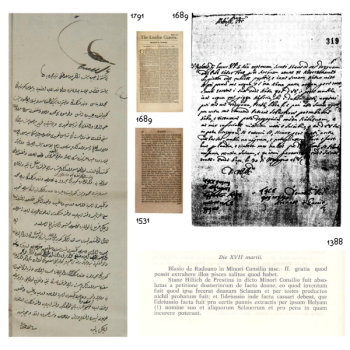It is often believed that sometime around the year 1389 were laid the foundations of the mosque of Çarshi (Market), which today is located in front of the Assembly of Kosovo. This information comes from one of the two inscriptions of the mosque. A more recent reading of this inscription push forward the laying of the foundations of the mosque a few decades later, at the time of Murat II, in the years 1421-1451. Its location at that time must have been near the city market (as it was later as well). This market is clearly mentioned for the first time in 1424 in some court documents of Ragusa. The Potoçishte neighborhood is also mentioned there,1 which had an exercise and sports field nearby, where, among other things, knight games were held in December. In 1448, about 200 people from Ragusa are known by name in Pristina. Their number is thought to have been even greater. When considering the total number of 1,700 inhabitants, it is evident that the Ragusan community has been significant in Pristina (about 15% of the population). Meanwhile, in 1461, according to the inscription that is there today, it is known that the mosque of Sultan Mehmet Fatihu was built. A few years earlier in 1454–1455, the city also finally came under Ottoman administration. Thus, in 1477, we have the first Ottoman census of the population with 9 neighborhoods, all Christian. About a decade later, a Muslim neighborhood (community) also appears in the next census of the Ottoman authorities, which seems to have been mainly concentrated near the city market. In this century, sometime in the second half, the city's hammam, located near the Fatih Mosque (Great Mosque), must have been built.
As to the placement of neighborhoods we can only make guesses on the basis of scant circumstantial data. The Llukar neighborhood is supposed to have been in the direction of today's Llukar. Whenever there is any connection between these two names. Lagjja Potoçishte, since as a Slavic name it means a running field, it must be imagined that it was in the flat part near the city, i.e. somewhere near the market (extending in the direction of the part where the city stadium is today).2 The neighborhood Poyasar, probably related to what was later known as the occupation of trays, usually in descriptions it is emphasized that they were dependent on the use of water, therefore it must have been near the river Prishtevka, where even later trays were located. Lagjja Koçaniko, although with many question marks, may be a name connected to the road to Kaçanik, which is also mentioned by Martin Segoni in 1479 (Cazanicj) in one of his notes. Since the Kosiriq neighborhood appears to be reduced in 1526, we assume it was somewhere closer to the center, where the Muslim population was growing. At the beginning of the 19th century, the Slavic population was concentrated in the northeastern part of the city, so it must be believed that those neighborhoods of Pristina had an increase in Christian residents starting from the 15th and 16th centuries. Such are the neighborhoods of Koçaniko, Shtitar and Llukar. At this time, according to the testimonies of the time, a Catholic church also functioned in Pristina,3 but its location is unknown.
1 While Jireček in 1892 was of the opinion that the word 'Potočishte' came from the Slavic poteci, potesti, with the meaning of moving, running, a more critical review of this interpretation seems necessary, the word Potočishte can also be related to the Slavic word potok, which is prophetic. The impact area may have been in a place near streams, something that is constantly mentioned when talking about Pristina in history. Always staying within the domain of hypotheses, such a location would have been near the current stadium of the city, where the two streams (rivers) Vellusha and Prishtvka meet.
2 As an alternative possibility, equally possible, is that the Potoçishte neighborhood was later renamed to Panaxhurishte. In that case, it will be searched for in the area where the National Theater of Kosovo is today, and where the mosque of Llokaç was built in 1551.
3 The researcher Gj. Berisha believes that at this time Pristina even had two Catholic churches. Khs. Durim Abdullahu, In the footsteps of the origins of Pristina.

